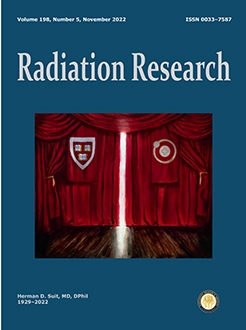Lung is one of the high-risk organs for radiation-induced carcinogenesis, but the risk of secondary lung-cancer development after particle-beam therapy and the underlying mechanism(s) remain to be elucidated. To investigate the effects of particle-beam radiation on adjacent normal tissues during cancer therapy, 7-week-old male and female B6C3F1 mice were irradiated with 0.2–4 Gy of gamma rays (for comparison), carbon ions (290 MeV/u, linear energy transfer 13 keV/µm), or fast neutrons (0.05–1 Gy, mean energy, ∼2 MeV), and lung-tumor development was assessed by histopathology. Mice irradiated with ≥2 Gy of carbon ions or ≥0.2 Gy of neutrons developed lung adenocarcinoma (AC) significantly sooner than did non-irradiated mice. The relative biological effectiveness values for carbon ions for lung AC development were 1.07 for male mice and 2.59 for females, and the corresponding values for neutrons were 4.63 and 4.57. Genomic analysis of lung ACs revealed alterations in genes involved in Egfr signaling. Hyperphosphorylation of Erk and a frequent nuclear abnormality (i.e., nuclear groove) were observed in lung ACs of mice irradiated with carbon ions or neutrons compared with ACs from non-irradiated or gamma-ray-irradiated groups. Our data indicate that the induction of lung AC by carbon ions occurred at a rate similar to that for gamma rays in males and approximately 2-to 3-fold greater than that for gamma rays in females. In contrast, the effect of neutrons on lung AC development was approximately 4- to 5-fold greater than that of gamma rays. Our results provide valuable information concerning risk assessment of radiation-induced lung tumors after particle-beam therapy and increase our understanding of the molecular basis of tumor development.
How to translate text using browser tools
30 August 2022
Lung-Cancer Risk in Mice after Exposure to Gamma Rays, Carbon Ions or Neutrons: Egfr Pathway Activation and Frequent Nuclear Abnormality
Kenshi Suzuki,
Shunsuke Yamazaki,
Ken-ichi Iwata,
Yutaka Yamada,
Takamitsu Morioka,
Kazuhiro Daino,
Mutsumi Kaminishi,
Mari Ogawa,
Yoshiya Shimada,
Shizuko Kakinuma





